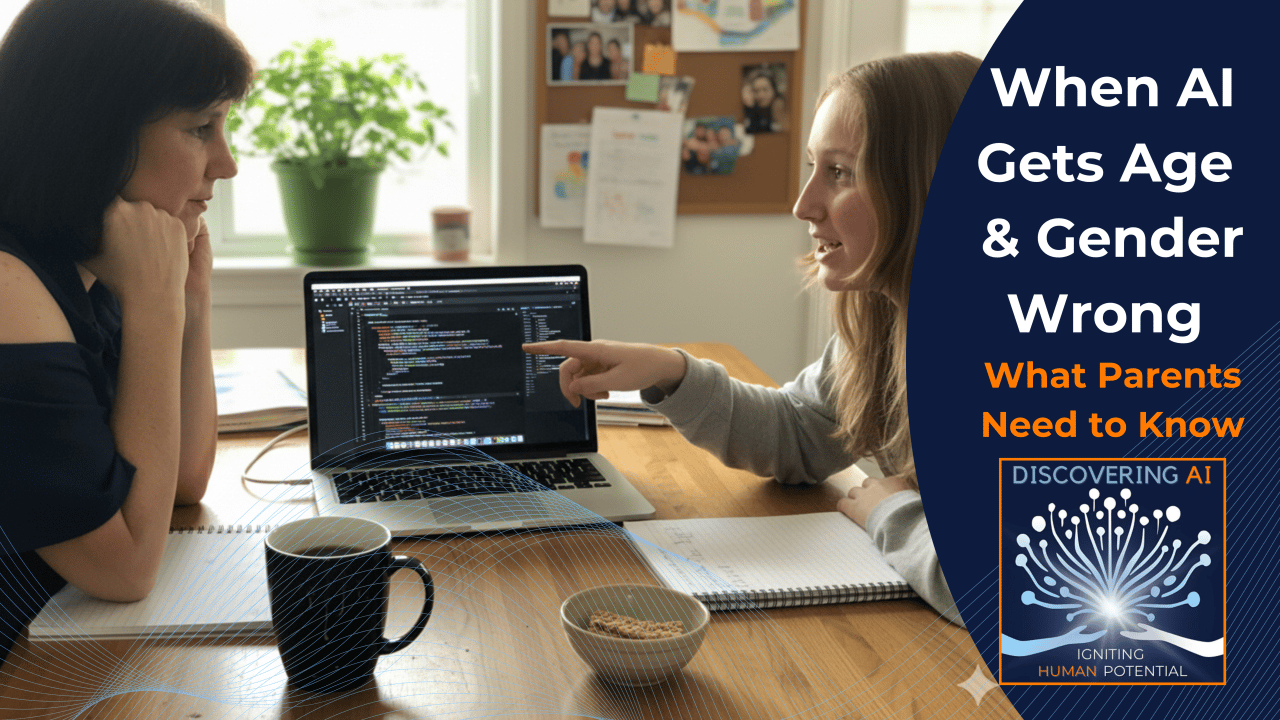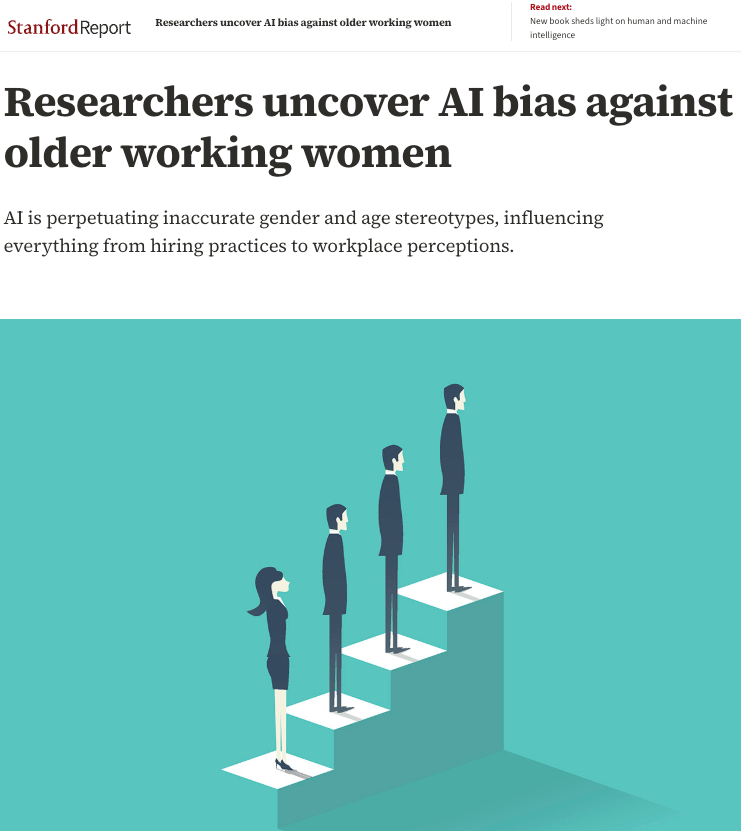- DISCOVERING AI: Learn It. Live It. Lead with It!
- Posts
- When AI Gets Age (and Gender) Wrong: What Parents Need to Know
When AI Gets Age (and Gender) Wrong: What Parents Need to Know

DISCOVERING AI: Learn It. Live It. Lead with It! At home, at work, and in the world.
By Amy D. Love, Founder of DISCOVERING AI
Stanford researchers recently validated something both unsurprising and unsettling: today’s most advanced AI systems show clear bias against older women in the workforce. In their experiments, large language models like ChatGPT and other generative tools consistently depicted women as younger, less experienced, and less authoritative than equally qualified men.
The findings echo what many women already know from lived experience, except this time, the bias isn’t just showing up in a meeting or a job posting. It’s being coded into the digital tools our children will grow up using.
And while this research focused on age and gender bias, it likely represents something larger. If AI systems absorb the data we feed them, it’s reasonable to assume similar distortions exist across race, geography, and socioeconomic experience too. The patterns may vary, yet the root issue remains the same, AI learns from us, and it learns our flaws as quickly as our brilliance.
This research matters for parents, not just professionals. Because if AI learns from human data, it also learns human bias. And that means our kids need the skills and mindset to question it.
AI Mirrors the Data It Inherits
The Stanford team, collaborating with researchers at Berkeley Haas, found that large language models trained on billions of text and image samples consistently associate age and gender with occupational worth.
When asked to create professional résumés for male and female candidates with identical qualifications, the AI generated descriptions that subtly diminished women’s experience. When prompted with the same job titles, women were portrayed as younger, while men were shown as more senior or established.
The study concluded that biases baked into training data persist even when the systems are fine-tuned. In other words, you can’t fully filter out prejudice once it’s learned. The only real fix is to change the way AI is built, tested, and questioned which starts with human discernment.
That’s where parenting comes in.
Bias in Code Is Bias in Culture
Every dataset reflects the society that created it. When women’s achievements are underrepresented, or when older professionals are portrayed as less adaptable, those distortions become digital defaults.
This is why AI’s future isn’t just a technical challenge, it’s a moral one. As parents, the question isn’t only “What can AI do?” It’s “What is AI learning from us, and what are our children learning from it?”
Each time we talk about fairness, kindness, or representation at home, we’re planting seeds for how our children will approach technology later. Those values shape whether they’ll become passive consumers of biased systems or active creators who challenge them.
The Coding Conversation Every Parent Should Have
This week, my daughter asked me if she really needs to learn coding.
My answer came quickly: Absolutely.
She may not become a software engineer. Yet understanding how code works and how bias can enter a system is essential to navigating a world run by algorithms.
I told her that in the future, people who can validate the quality of AI-generated work will be invaluable. They’ll be the ones who catch the hidden bias, question the source, and safeguard fairness when machines can’t.
That’s not just a skill. It’s a form of integrity.
In RAISING ENTREPRENEURS: Preparing Kids for Success in the Age of AI, I wrote that the children who thrive will be those who blend human empathy with technical fluency. Coding fluency isn’t only about syntax. It’s about systems thinking, understanding how decisions made upstream influence what comes downstream.

Rooting Out Bias Starts Early
The Stanford research team noted that bias in AI is “not a glitch, it’s a reflection.” AI reproduces the inequalities of the data it’s trained on. If certain groups are undervalued in that data, AI will keep undervaluing them.
As parents, we can model what it looks like to challenge those patterns. When a commercial only shows boys building robots, we can ask, “Why do you think that is?” When an AI image tool generates mostly male CEOs or younger professionals, we can prompt it differently and discuss the results.
These small conversations teach children two things:
Bias hides in everyday systems.
Awareness gives you the power to fix it.
This is the foundation of what I call intentional parenting in the Age of AI, raising children who question information, understand systems, and connect technology to their values.
Coding as the New Literacy
The world is moving toward a divide not between those who can code and those who can’t, but between those who understand code and those who don’t know when it’s wrong.
You don’t need to turn your child into a computer scientist. You just need to help them see code as language, one that shapes nearly every system they’ll interact with.
When they understand how a simple “if/then” statement works, they start to see how bias creeps in. “If” the training data underrepresents older women, “then” the model’s results will too.
That’s why I encourage families to explore coding concepts through play. At DISCOVERING AI, we call this hands-on learning MindSpark™, weekly activities that invite families to learn, create, and reflect together using AI in meaningful ways.
These are not lessons or lectures. They are small, real-life moments that turn curiosity into confidence:
Use AI, then compare how it describes different characters. Does it assign certain roles or traits more often to one gender or age group?
Ask your child to adjust the prompt, changing a few words, names, or occupations, and see how the output changes.
Talk about why those differences matter. What assumptions might the AI be making? What could your child do to make it fairer or accurate?
Try a coding-focused MindSpark™, like having your family create a simple “If/Then” decision tree about something fun (“If it’s raining, then we build a fort; if it’s sunny, then we go hiking”). It teaches logic and problem-solving in the same way programmers think.
Each MindSpark™ builds what we call the Six Traits of Future-Ready Kids: adaptability, creativity, critical thinking, emotional intelligence, tech fluency, and initiative.
You’re not just teaching coding. You’re teaching critical thinking, ethics, and reflection. You’re showing your child that technology isn’t something to fear or follow blindly, it’s something to understand, shape, and lead with purpose.
Why This Matters for the Next Generation
The Stanford findings are more than a research milestone. They’re a reminder of how easily our assumptions can become embedded in the systems our children will depend on.
The next generation will inherit tools that can either amplify bias or dismantle it. Whether they do one or the other will depend on the habits we help them build now: curiosity, ethical reasoning, and the courage to question what seems certain.
AI literacy begins long before a coding class or computer lab. It begins around the dinner table, in the car, or during a homework conversation, when children start connecting fairness and truth to the tools they use every day.
What Parents Can Do This Week
Here are three simple ways to start the conversation:
1. Spot the Pattern.
Next time you use an AI image or writing tool together, look at who appears. Are they mostly male, young, or from one background? Ask your child, “Who’s missing?”
2. Debug the Data.
Show your child that AI isn’t magic, it’s math and data. Talk about how mistakes in training data can lead to unfair outcomes, just like errors in homework can change a grade.
3. Build the Skill.
Encourage learning the logic of code through creative tools like Scratch or Python-based art generators. Even small exposure builds confidence and discernment.
Rooting out bias isn’t about blaming technology. It’s about preparing our children to lead with clarity and conscience.
A Final Reflection
When I think about the Stanford findings, I don’t just see an academic study. I see a mirror showing us where our culture still undervalues experience, especially the wisdom of women who’ve built careers, families, and communities.
AI will keep learning from us. The question is: What are we teaching it?
The next generation doesn’t just need to learn how to use AI. They need to learn how to question it, shape it, and lead it.
That starts with parents who believe that understanding code, and the human stories behind it, is part of raising future-ready kids.
Because every time we help a child connect values to technology, we’re writing a better algorithm for the future.
Explore more ways to raise creators, not just consumers, at DiscoveringAI.org
#CreateMoreConsumeLess #DiscoveringAI #ParentingInTheAgeOfAI
📘 If you are ready to start your own family’s conversation, explore my book DISCOVERING AI: A Parent’s Guide to Raising Future-Ready Kids
and download your free FAMILY AI GAME PLAN™ at DiscoveringAI.org.
𝐃𝐢𝐬𝐜𝐨𝐯𝐞𝐫𝐢𝐧𝐠 𝐀𝐈: 𝐋𝐞𝐚𝐫𝐧 𝐈𝐭. 𝐋𝐢𝐯𝐞 𝐈𝐭. 𝐋𝐞𝐚𝐝 𝐰𝐢𝐭𝐡 𝐈𝐭.
At home, at work, and in the world.
Want to learn more, follow me here 💠 Amy Love 💠, and subscribe to the DISCOVERING AI newsletter.

